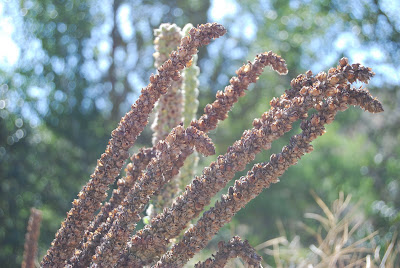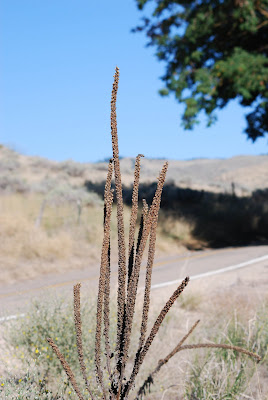


They were one of the first European pioneers in North America and probably the most tenacious, and they followed the footsteps of other discoverers along established roads and trails. Plowed fields and other areas newly disturbed my man were also a favorite place of settlement. Which pioneer was this? Well is was the Common Mullein (Verbasum thapus) of course, the plant honyocker, settler, homesteader and squatter, of the plant world. Some know this plant by the name of Hag-Taper.
The common mullein isn't native to the United States and was an introduced from Eurasia. It's a member of the figwort family and produces a stalk that is somewhat woody, unbranched and 2-8 foot tall, with yellow flowers that occur in dense , spike like racemes, with flannel like leaves. Mullein is classified as a biennial which means the first year the seed sprouts it forms a rosette of low growing silver-gray leaves and the second year it grows a long stalk with flowers, then the plant dies.
Mullein probably made it's first appearance in North America during colonial times when it was used as a medicinal herb and a wrapper for food, to keep it from spoiling. There are a number of other reported medicinal uses of this plant including treatment for coughs, pneumonia, and insect bites, which I cannot vouch for. The Indians of North America used mullein for tobacco, and healing smoke for respiratory problems and to make drill spindles for friction fire starting. Birds feed on the seed pods of mature plants, which provide a ready source of seed especially during the winter when the snows are deep.
In more ancient times mullein was known for magical properties and sprigs of mullein were passed through a fire in order to protect cattle from sickness brought on by sorcery. The Potowatami Indians smudged unconscious folks with the leaves to help revive them.I often see mullein growing along dirt roads, and sometimes in open forest lands where fires have burned and in the canyons along the Owhyee River I have seen it growing scattered amongst the bunch grasses, like so many small trees. The soft leaf is one of the most remarkable features of this plant and it does feel like a piece of flannel. It's like you could use it to clean off your computer screen or even wipe the film off your glasses. The tall straight stalks remind me of a lance or spear, as if some ancient warrior stuck it in the ground to mark the way.
I think the most magical thing about mullein is its ability to grow in very dry areas, on disturbed soil and to grow so straight and tall. And as far as the medicinal uses, magic and sorcery I will leave that to others to fathom, but maybe I will keep a few mullein leaves around the house..... just in case.
No comments:
Post a Comment